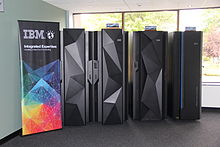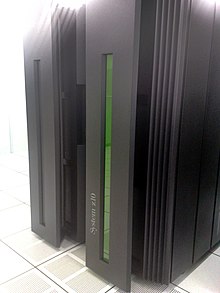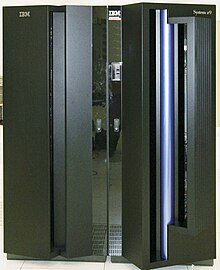IBM Z
The systems are built with spare components capable of hot failovers to ensure continuous operations.First layer virtualization is provided by the Processor Resource and System Manager (PR/SM) to deploy one or more Logical Partitions (LPARs).[citation needed] IBM Z's PR/SM and hardware attributes allow compute resources to be dynamically changed to meet workload demands.CPU and memory resources can be non-disruptively added to the system and dynamically assigned, recognized, and used by LPARs.[16][17] A z14 system can have a maximum of 240 Processing Unit (PU) cores, 170 of which can be configured to the customer's specification to run applications and operating systems, and up to 32 TB usable redundant array of independent memory (RAIM), some of which can be configured as Virtual Flash Memory (VFM).The focus of the IBM Z systems are pervasive encryption as the z14 processor has plenty of hardware assisted cryptography features (AES, DES, TDES, SHA, Random number generator).In June 2014, IBM announced[25] it had shipped its first Enterprise Cloud System to Vissensa, a UK-based managed service provider.zEnterprise Business Class 12 – The zBC12 is an entry-level single-rack solution, was introduced in July 2013 and is available in two hardware models, the H06 and the H13.Additional cores are reserved as spares, SAPs and IFPs.Introduced in August 2012, the zEnterprise EC12 is based on the zEC12 chip, a 5.5 GHz 8-core out-of-order CISC-based z/Architecture processor.The EC12 has 50% higher total capacity than the z196 (up to 78,000 MIPS), and supports Transactional Execution and Flash Express – integrated SSDs which improve paging and certain other I/O performance.zEnterprise, announced in July 2010, with the z196 model, was designed to offer both mainframe and distributed server technologies in an integrated system.The z114 supports up to 248 GB (usable) of redundant array of independent memory (RAIM).zEnterprise 196 – The z196 is a high-end dual-rack solution, and available in five hardware models: M15, M32, M49, M66 and M80.[32] Additional cores are reserved as spares and as SAPs.The 196's microprocessor is the z196 chip, a 5.2 GHz quad-core out-of-order CISC-based z/Architecture processor.The z196 can have a maximum of 24 processors giving a total of 96 cores, 80 of which are directly available to run operating systems and applications.The System z9 servers offered: Specific models from this family include: Announced on October 3, 2000, and available on December 18, the eServer zSeries 900 (z900 for short) was the first to feature the 64-bit z/Architecture extension of the S/360 architecture, still retaining the support for the 31-bit and 24-bit addressing programs back to 1964.[37][38] In 2002, IBM launched the z800, a lower-end mainframe featuring five Blue Flames clocked at 625 MHz, of which up to four can be Central Processors, all sharing an 8 MB L2 cache.[40] Featuring IBM's first superscalar CMOS mainframe processors, a dual-core chip contained 121 million transistors across 266 mm2, and was manufactured in a 130 nm process, drawing 55 Watts at 1.2 GHz in the z990.[44] The number of logical partitions was doubled to 30, and the maximum distance of Parallel Sysplex rose to 100 km.The Resource Manager can monitor the various platforms for signs of bottlenecks or faults and modify the overall system to recover, maintaining a specified quality of service level.[56] Each purchased PU (processor unit) is characterized as one of a variety of types: Also it's possible to run a zAAP-eligible workload on zIIPs if no zAAPs are enabled.The addition of IFLs, zAAPs, zIIPs, ICFs, SAPs or IFPs does not change the system capacity setting or its MSU rating, only CPs do.








IBM mainframes700/7000 series1400 seriesSystem/360System/37030XX seriesSystem/390eServer zSeries (900, 800; 990, 890)System z9System z10zEnterprise System (z196, zEC12)S/370-XAESA/370ESA/390z/ArchitectureIBM LinuxONEmainframe computersIBM System z10IBM System z9zero downtimefailoversbackward compatibilityVirtualizationhypervisorvirtual machinesCommon CriteriaEvaluation Assurance LevelOpenCAPITelum processorneural netsz15 chipz14 chipredundant array of independent memoryCentral ProcessorIntegrated Facility for LinuxIntegrated Information ProcessorCoupling Facilityz13 chipz Integrated Information Processorz Application Assist Processorconverged infrastructureOraclezEC12 chipout-of-orderz10 Integrated Information ProcessorTransactional ExecutionIBM BladeCenterz196 chipPower ISAService Request BlockAdvanced Encryption StandardeServer64-bitS/360 architectureaddressingmulti-chip modulesilicon on insulatorsuperscalarData Encryption Standardnon-uniform memory accessmemory disambiguationI/O channelslogical partitionsParallel SysplexLinux on IBM ZRed Hat Enterprise Linux 6SUSE Linux Enterprise Server 11Microsoft Windows Server 2008bladesPOWER7blade serversgameframe10 Gigabit Ethernet1 Gigabit Ethernetquality of serviceApplication Assist ProcessorInternal Coupling FacilitySystem Assist ProcessorList of IBM productsPeer to Peer Remote CopyExtended Remote CopyHiperSocketIBM Parallel SysplexIBM Secure Service ContainerHercules emulatorOpenSolaris for System zIBM z13IBM z196IBM zEC12ComputerworldArs TechnicaVance, AshleeInfoWorldHot ChipsThe RegisterIBM System/390IBM eServer zSeriesIBM zEnterpriseHistoryMergers and acquisitionsPC business acquisition by LenovoProductsMainframePower microprocessorsPower SystemsStorageFlashSystemDS8000Q System OneQ System TwoOspreyCondorBlue GeneCell microprocessorsPowerPCMidrange computerPersonal ComputerSelectricThinkPadCarbon Design SystemCloudantCognos AnalyticsConnectionsCriminal Reduction Utilising Statistical HistoryFortranInformation Management Software